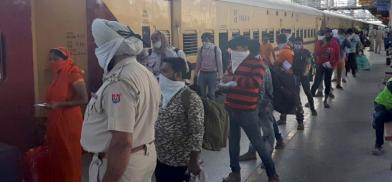Aurangabad tragedy a scar on the Indian consciousness: Migrant workers need more State empathy
The 2011 census had revealed that India has as many as 453 million internal migrants and this includes both inter-state migrants and those within each state. Absent credible national data for the last few years, some studies have suggested that this figure may now be in excess of 600 million, writes C Uday Bhaskar for South Asia Monitor

The images of mutilated body parts, torn bags, plastic slippers and scattered rotis strewn across the train tracks near Aurangabad on Friday (May 8) symbolized the heart-rending tragedy of the migrant workers whose lives have been wrecked by the COVID 19 lockdown. In a ghastly accident, a group of them who were walking to their rural homes from Jalna (Maharashtra) to Bhusaval (Madhya Pradesh) along the railway tracks – a distance of almost 160 km – fell asleep on the tracks - in the mistaken belief that no trains were running - closer to Aurangabad out of sheer exhaustion. Alas, most of them were run over by a goods train in the early hours of Friday. A total of 16 in the group of 20 lost their lives and will be part of the collateral deaths caused by the COVID lockdown.
Thousands more are in a similar situation of penury and dislocation that has forced them to walk to their homes in different parts of India, for the state had not anticipated the scale of the destitution that has afflicted the migrant worker since the national lockdown was first announced on March 24. Avoidable confusion about how to look after the welfare of millions of migrant workers suddenly deprived of their daily livelihood and a palpable lack of empathy characterised the approach of the Modi government as it sought to grapple with the enormity of a national lockdown.
The unintended irony was that Prime Minister Narendra Modi was exhorting the country to recall the wise and compassionate Buddha on his birth anniversary (May 7) and internalize the principles of compassion and mercy. Noting that Gautam Buddha’s teachings were even more relevant when there was “turmoil in the world”, Modi added that the imperative “for us in this hour of crisis is to help others as much as possible and to forward the hand of help.”
However, the migrant worker/ daily-wager has not been rendered the organized help that ought to have been extended as the highest priority for the state, when the COVID 19 national lockdown was being planned.
The 2011 census had revealed that India has as many as 453 million internal migrants and this includes both inter-state migrants and those within each state. Absent credible national data for the last few years, some studies have suggested that this figure may now be in excess of 600 million.
This migrant worker spectrum is relatively invisible but is the real workforce that keeps the Indian economy running. This demographic spectrum enables the more privileged Indian to maintain a comfortable and often self-serving societal rhythm and, whether as factory worker, farm labor or domestic help, the migrant worker / daily-wager / casual employee is integral and essential to the national pulse.
Regrettably, the migrant worker and related variants in India have not been accorded the institutional identity they warrant and hence they are devoid of rights – the same rights and entitlement that the more privileged have accorded unto themselves in the world’s largest democracy.
Thus an elected representative is entitled to a lifetime pension and other perks by winning just one election and the government employee is similarly looked after with various fiscal and welfare provisions – but none of these are available to the unorganized and informal workforce. The migrant worker is at the bottom of this pyramid and the manner in which the less affluent among them are relegated to slums and shanties where even water and other amenities are not available points to the total lack of compassion by both state and society.
Specific to the COVID lockdown, the Modi government could have planned for the welfare of the migrant workers in a more empathetic and humane manner. Enough think-tank data exists to indicate that four states account for almost 50 percent of the inter-state migrants in India, being Uttar Pradesh 25 percent ; Bihar 14 percent ; Rajasthan and Madhya Pradesh being 6 and 5 percent respectively.
This translates to about 5 million migrant workers who would have wanted to go back to UP, followed by about 2.5 million to Bihar, a million to Rajasthan and about 800,000 to Madhya Pradesh. India has adequate institutional capacity to deal with the movement of such numbers in a planned manner - but this was not envisioned. Consequently, there has been a reactive response – often seen as police intimidation of the most vulnerable and compassion is totally missing.
India is still grappling with the early stages of the COVID pandemic and it is feared that the scale of the human suffering will increase exponentially. Various exigencies would have to be anticipated and human deprivation avoided. Providing food to the displaced is yet to be given the priority it deserves and hunger deaths avoided.
For PM Modi, the lodestar during the pandemic must be Chanakya’s dictum of ensuring ‘yogakshema’ – or the well-being of each and every citizen of India irrespective of socio-economic status. They have constitutional rights that need to be recognized and respected and provided for by the state. Perhaps the time has come to create an independent department for the migrant worker akin to the one created for the overseas Indian.
The scattered rotis on the Aurangabad train tracks will be an indelible scar on the Indian collective consciousness – at least that cross-section which still retains a modicum of compassion.
(The writer is Director, SPS. The views expressed are personal. He can be contacted at cudaybhaskar@spsindia.in)









Post a Comment